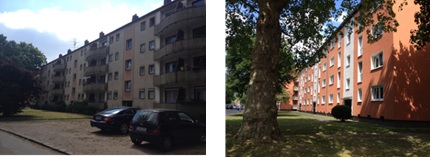IoT Data Analytics – A key enabler for the Growth of Smart Cities
In an urban context both citizens and city officials are getting increasingly overwhelmed with data streams from sensors such as GPS devices, cameras, induction loop data, smart meters and a multitude of other sensor data. In order for cities to thrive and offer a desirable environment to be in, it is crucial that such heterogeneous data streams can effectively be managed and analyzed so that actionable decisions can be made. But further to urban challenges related to planning and operations, citizens and people visiting or living in the city judge it by the services that can be provided in their daily lives, be it business, work or leisure time. In this article we will present a small selection of IoT Data Analytics solutions that AGT International is developing as part of three H2020 Smart City Projects funded by the European Commission, namely GrowSmarter, CPaaS.io and VaVeL. We will sketch how analytics developed for concrete Smart City challenges, addressed primarily at city officials, can further be developed to create innovative services for individual people and third parties.
Introduction
When developing Smart City applications, it is as for any commercial application, important to understand the customer and their needs. While it is understood that a city needs to effectively manage its traffic, transport, energy, waste or public safety to name a few, it may not always be as clear who the actual customer is. The aforementioned management challenges can easily be mapped to the respective stakeholders in the city administration. However, as part of the open data initiatives, many cities (consider for instance Vienna, Dublin or Cologne) see opportunities in publishing data sets and encouraging and fostering a community of application developers to provide innovative services. On one hand this means that people living and visiting a city increasingly move into the focus of the application design process. On the other hand it means that there is an explorative space to develop innovative applications for which the needs and value is only emerging. Obviously this both creates an opportunity to develop innovative and possibly disruptive services and poses a challenge to identify the needs that are addressed by the solution.
Common to the aforementioned Smart City application domains is that they require data-intensive services and powerful, reusable IoT analytics that are able to create actionable insights. AGT International is a pioneer in IoT Analytics and Big Data integration covering the domains of Smart Cities, Industry 4.0 and Social IoT. Gartner called AGT International one of four “Cool Vendors in IoT Analytics”. Understanding that analytics optimally enable applications if they are provided as part of a platform in which they can easily be customized for the various applications, we continuously develop our analytics enablers in a holistic way identifying synergies between applications both for which customer needs are clear and emerging. In this article we show how we follow this idea of having a holistic perspective on IoT analytics across Smart City application in the context of our current H2020 research projects GrowSmarter, CPaaS.io and VaVeL. In this article we are only able to touch on a very small sample of Smart City IoT analytics. Some more information about our analytics and application domains can be found in an article by Daniel Harris, one of Software AdviceTM Market Researchers, about 4 Emerging Use Cases for IoT data analytics.
Grow Smarter
GrowSmarter seeks to reduce the overall energy footprint in cities by 60%. GrowSmarter brings together cities and industry to integrate and demonstrate ‘12 smart city solutions’ in energy, infrastructure and transport, providing blueprints for the cities of the future. GrowSmarter is a joint effort of three lighthouse cities in Europe (Stockholm, Barcelona, and Cologne) each with an individual city consortium including industry, city departments, and academia. Furthermore, 6 follower cities (Graz, Suceava, Malta, Porto, and Cork) will implement the most suitable blueprints of the 12 solutions. As part of GrowSmarter the Stegerwald Siedlung with approx. 1,400 homes in Cologne will be turned into a smart district.

Figure 1: The Stegerwald Siedlung. Left: Original houses. Right: Refurbished houses
Energy consumption and production is one critical element in every city. The houses in the Stegerwald Siedlung will be refurbished using energy-saving materials, but some will also install Smart Energy solutions to support energy savings. AGT International has developed a sophisticated data analytics engine allowing a precise prediction of energy consumptions in homes. These information will give tenants a good insight into their energy usage behaviour down to the device level using smart plugs. The backend provides a user interface showing current consumption for the individual rooms or devices. Additionally, a historic view allowing comparison between different time intervals could be chosen. The high frequency of data capturing enables the creation of an individual user energy consumption profiles. Part of the energy data analytics AGT has developed is using this energy pattern allowing a prediction of the energy consumption for the next half an hour. This is far more precise than the standard load profile used by German energy providers. Combined with an installed battery and photovoltaic installations on roof tops, a reduction of primary energy from the grid will be achieved.
Additionally, rich energy consumption patterns provide a behavioural insight to its inhabitants. Using the high frequency energy data we were able to develop a method which recognizes certain activities of the tenants. These information could be used for detecting abnormal behaviour in a household e.g. in a burglary case or detecting dangerous situations in elderly care settings.
VaVeL
The goal of the VaVeL project is to radically advance our ability to use urban data in applications that can identify and address citizen needs and improve urban life. The project brings together two European cities, Dublin and Warsaw that provide diverse large scale data of cross-country origin and real application needs, three major European companies in this space, and a strong group of researchers that have uniquely strong expertise in analyzing real-life urban data.

As one major part of AGT, VaVeL offers an automatic traffic congestion and anomalies detection system based on CCTV data provided by the City of Dublin. In addition, this automatic system will be extended based on Deep Learning methodologies to further enable the detection of relevant street situations such as flooding or emergency incidents.
Both is illustrated in Figure 2, where on the top left our analytics identified a congestion as high traffic flow. On the top right and bottom further problematic situations are shown which will be detected either indirectly as an anomaly of traffic flow or directly using image recognition techniques based on Deep Learning.
In order to come to an efficient user interface, we furthermore investigate how the interaction between the automatic detection system and the operators in the command & control centre can be optimized. To this end we use a vision-based system that is able to track the operator’s attention to the output of the system. This way, for example the urgency of an event can be increased if none of the operator was able to review it.
On one hand, the solution will help to substantially decrease reaction time of traffic operators to potential incidents and to better manage city traffic. On the other hand, together with the consortium partners, the output of VaVeLs CCTV Analytics will be combined with various other data sources and analytics insights in one Big Data platform that makes European urban data more accessible and easier to utilize. This way citizens of the EU can benefit in areas such as transportation and infrastructure.
CPaaS.io
In the CPaaS.io project AGT International is applying its analytics components to provide citizens and tourists an enhanced user experience, i.e. an automatically generated experience log based on sensor data collected from devices such as mobile phones, wearables and mobile cameras. While such an experience log can in principle cover all activities in a city, we initially address activities while visiting events such as mass sport and fun events.

Figure 3: Color Runners getting sprayed with pink colour
This way we are exploring innovative applications at the intersection of our Smart Cities and Social IoT vertical. As an initial event we are considering the Color Run, a global event series that takes place in many cities around the world. At the Color Run, participants run a distance of five kilometres and are being sprayed with colour on their way. As the event focuses on health and fun rather than athletic achievements the aim for the participants is to reach the finish line rather than comparing the running time with other runners. At the finish line the runners gather to party and dance to music while getting sprayed with more colour.
The experience log application fits into the category of explorative Smart City applications. In this application we are re-using existing analytics component in our platform minimizing the effort to build and evaluate their business potential. For instance consider that one analytics component we are using, detects emotions by looking at the faces of persons obtained from mobile cameras. Emotions like happiness, could be aggregated in certain areas in the city thus becoming part of a city pulse application that provides awareness about people’s emotional states over time. From a technical perspective we can reuse the emotion analytics developed as part of our IoT Analytics platform (IoTA). The emotion analytics components in turn is built on a reusable video processing pipeline that is also used by the attention monitoring component described above. In addition, through our platform services we can easily add additional components to enrich the overall experience. This could be both vision-based components as well as more general data analytics and machine learning capabilities. For instance we are considering to re-use our behavioural analytics components described above to obtain insights about how people move around in a city or event.
CPaaS.io perfectly enables the exploration of applications with emerging value such as the enhanced user experience application sketched above. CPaaS.io is a joint R&D project between Europe and Japan and develops a City Platform as a Service that is designed to cover a wide range of different type of applications. In particular it focuses on enabling cross-regional applications that rely on personal and Linked Data. In total it covers 3 diverse use case and 5 application scenarios. Our enhanced users experience application is part of the Managing Fun and Sports Events use case that also includes a Visitor Experience application targeting the Sapporo Snow Festival and a Public Transportation application for the city of Tokyo. CpaaS.io is currently in its first phase in which applications are being developed on top of the platform. In parallel we are currently defining IoT analytics scenarios that show how applications for Managing Fun and Sports events can work across regions, i.e. in Europe and Japan.
Summary
Smart City applications are optimally enabled by IoT analytics if they can be applied to a range of diverse data sets and applications. In order to develop innovative applications with emerging business and societal value, it is important to take a holistic approach and experiment with new, sometimes non-obvious features and functionalities powered by suitable analytics components. Technically this needs to be supported by platforms such as AGT’s IoT Analytics platform (IoTA) that offers customizable analytics components in order to rapidly develop innovative applications. VaVeL, GrowSmarter and CPaaS.io have significant potential to contribute to the challenge of accelerating time-to-market and increasing the number of available Smart City applications. In its research projects, AGT International is investigating these accelerators by (1) developing re-usable and transferable computer vision solutions starting from known challenges related to traffic management, (2) developing re-usable and transferable time-series based analytics for reducing energy-consumption in smart homes, and (3) developing a Smart City platform that deals with personal data, cross-regional applications and supports the experimentation of novel applications with emerging business and societal value.
Acknowledgements and Disclaimer
 The work described in this article is partly carried out in the context of the VaVeL, GrowSmarter and CPaas.io projects. These projects have received funding from the European Union’s Horizon 2020 research and innovation programme under grant agreement No. 688380 (VaVeL), No. 723076 (CPaaS.io) and No. 646456 (GrowSmarter). The opinions and view described in this article only reflect the authors’ view. The European Commission is not responsible for any use that may be made of the information this article contains.
The work described in this article is partly carried out in the context of the VaVeL, GrowSmarter and CPaas.io projects. These projects have received funding from the European Union’s Horizon 2020 research and innovation programme under grant agreement No. 688380 (VaVeL), No. 723076 (CPaaS.io) and No. 646456 (GrowSmarter). The opinions and view described in this article only reflect the authors’ view. The European Commission is not responsible for any use that may be made of the information this article contains.
 Create PDF
Create PDF

 Beiträge als RSS
Beiträge als RSS
Dein Kommentar
An Diskussion beteiligen?Hinterlasse uns Deinen Kommentar!